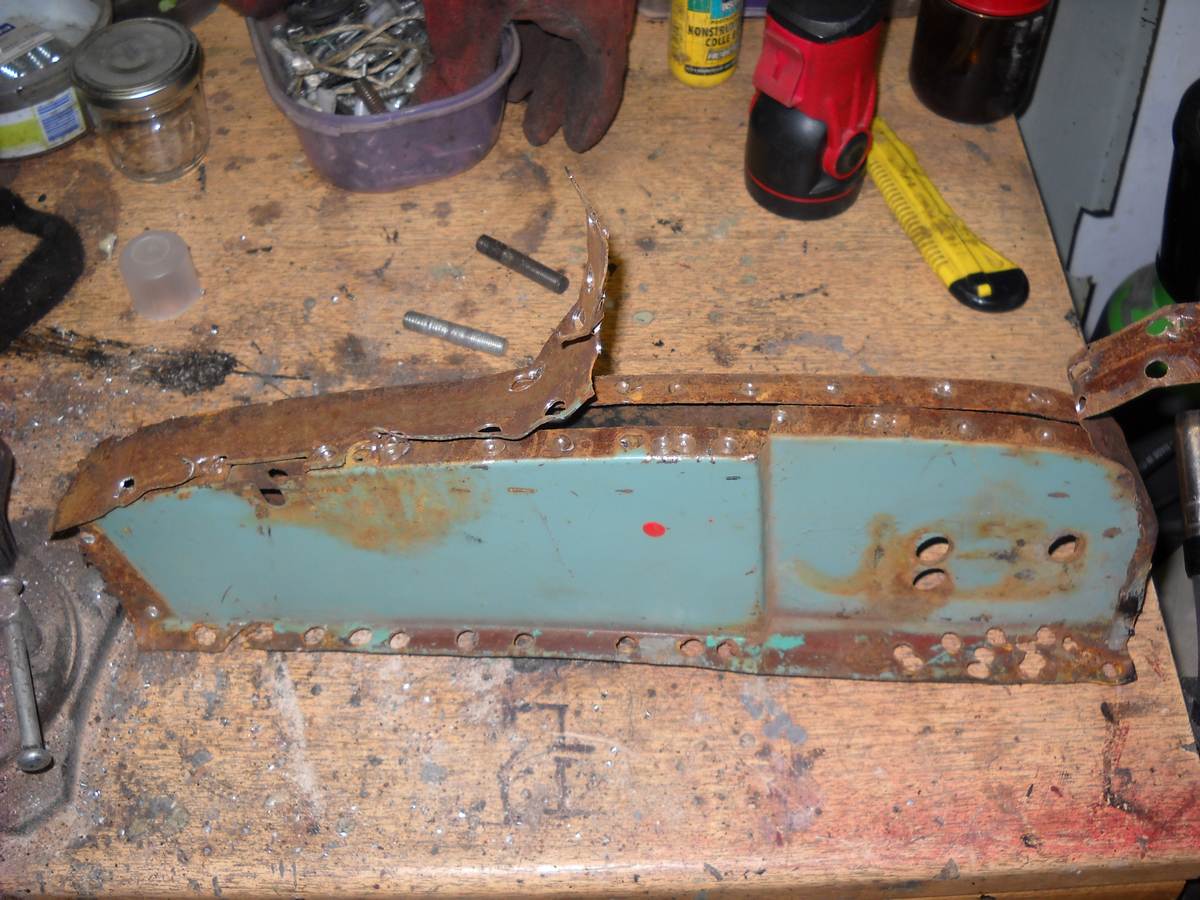Body work
Inner sill repair
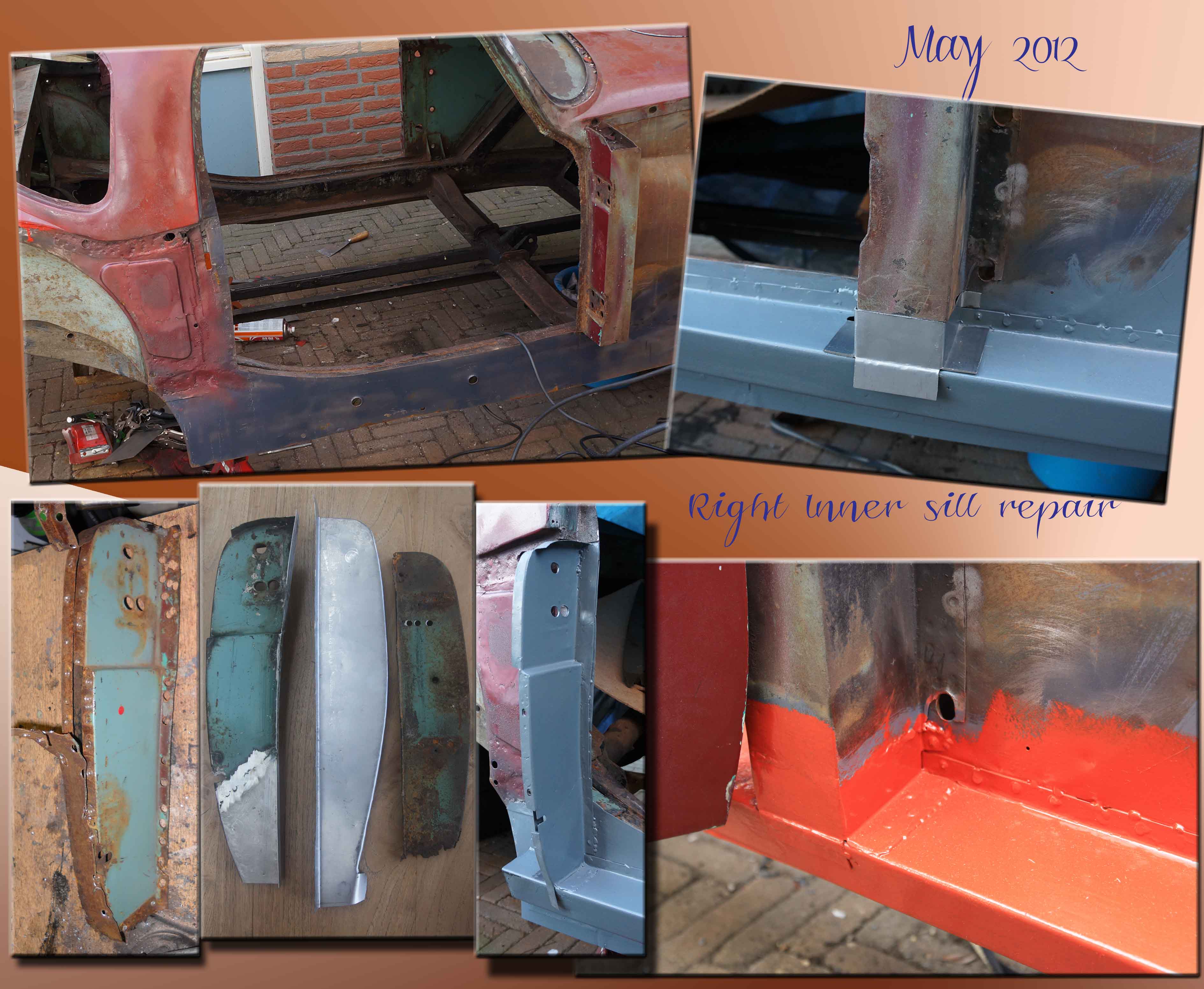 With the MGA the inner sills are not visible once the car is completely assembled. Still dirt and moist knows how to get there. The fenders covering the inner sills showed some rust damage and indeed as almost always in such cases, the rust damage was much worse than it seemed at the first glance. Both inner sills were so bad that they had to be replaced. First remove the old sill by drilling out the spot welds. On the right-hand side the panel, which the sill was welded on was also in bad shape and needed replacement too.
With the MGA the inner sills are not visible once the car is completely assembled. Still dirt and moist knows how to get there. The fenders covering the inner sills showed some rust damage and indeed as almost always in such cases, the rust damage was much worse than it seemed at the first glance. Both inner sills were so bad that they had to be replaced. First remove the old sill by drilling out the spot welds. On the right-hand side the panel, which the sill was welded on was also in bad shape and needed replacement too.
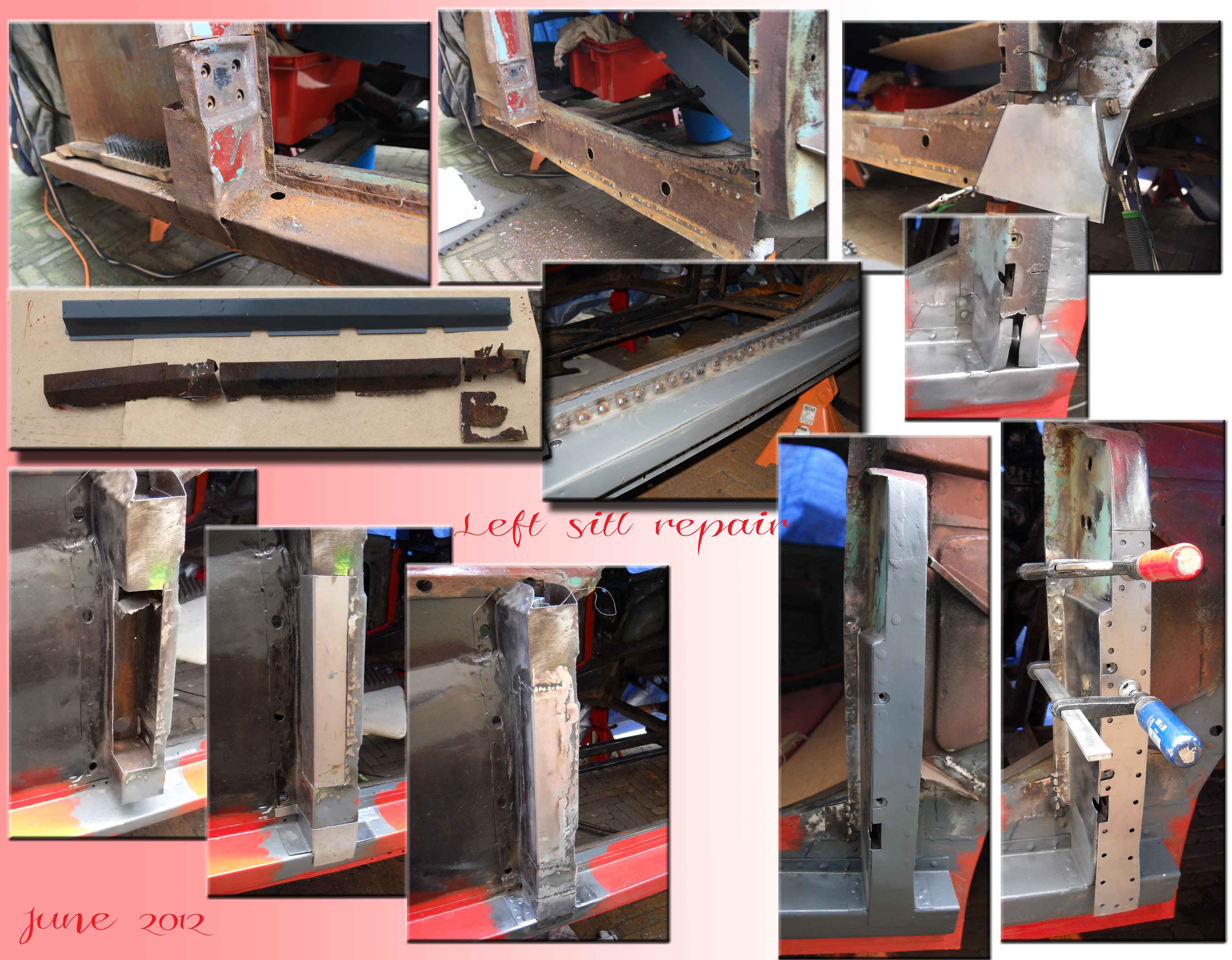 We painted the inside and the outside of the new sills to protect it from rust. The areas where the welds will come were covered with tape to prevent epoxy paint from coming too close to the welds. The welding area themselves got a coat of weld primer. The 5mm metal punch was a great asset when punching 5mm holes for the welds in the sills: Over a 100 plug welds per sill. I'm getting better at it and so the 2nd sill hardly needed any grinding at all. Enough wire speed and current to fill up the holes nicely. After the sill was fitted to the car, the lower-end of the posts needed to be reconnected. Formed a new piece from a 1mm thick piece of sheet metal.
We painted the inside and the outside of the new sills to protect it from rust. The areas where the welds will come were covered with tape to prevent epoxy paint from coming too close to the welds. The welding area themselves got a coat of weld primer. The 5mm metal punch was a great asset when punching 5mm holes for the welds in the sills: Over a 100 plug welds per sill. I'm getting better at it and so the 2nd sill hardly needed any grinding at all. Enough wire speed and current to fill up the holes nicely. After the sill was fitted to the car, the lower-end of the posts needed to be reconnected. Formed a new piece from a 1mm thick piece of sheet metal.
On the left-hand side the A-post was bend due to a collision. It could not be straightened out while still on the car. So all the twisted parts were cut off and drilled out, hammered out on the bench and welded back in. The inside of the posted will be spray painted prevent further rust damage. The outside is painted with a 1K epoxy primer and few layers of paint. The paint layer does not have to be perfectly smooth and shiny, as long as it keeps the rust out. I did paint it in the final colour just to get a impression how the new colour will look on the car...
Making new floor panels
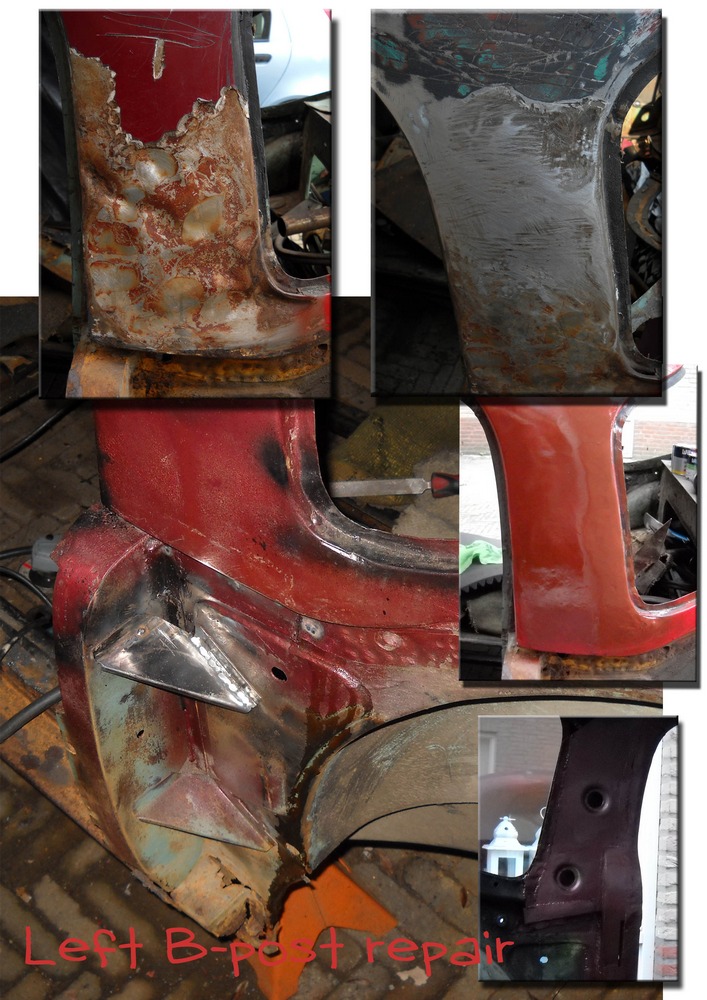 Up until now we have been removing badly rusted metal from the car body. It is time to turn that around at start adding metal to the car. The top of the B-post is now straight again. It was badly dented and filled with loads of filler. To be able to access it from the back, I cut away some sheet metal at the inside. Ather flattening out the outside panel, we could weld in the inside sheet metal again. At the same time pieces of metal are welded into the B-post. All that is left on this side is replacing the inner sill and the lower part of the B-post.
Up until now we have been removing badly rusted metal from the car body. It is time to turn that around at start adding metal to the car. The top of the B-post is now straight again. It was badly dented and filled with loads of filler. To be able to access it from the back, I cut away some sheet metal at the inside. Ather flattening out the outside panel, we could weld in the inside sheet metal again. At the same time pieces of metal are welded into the B-post. All that is left on this side is replacing the inner sill and the lower part of the B-post.
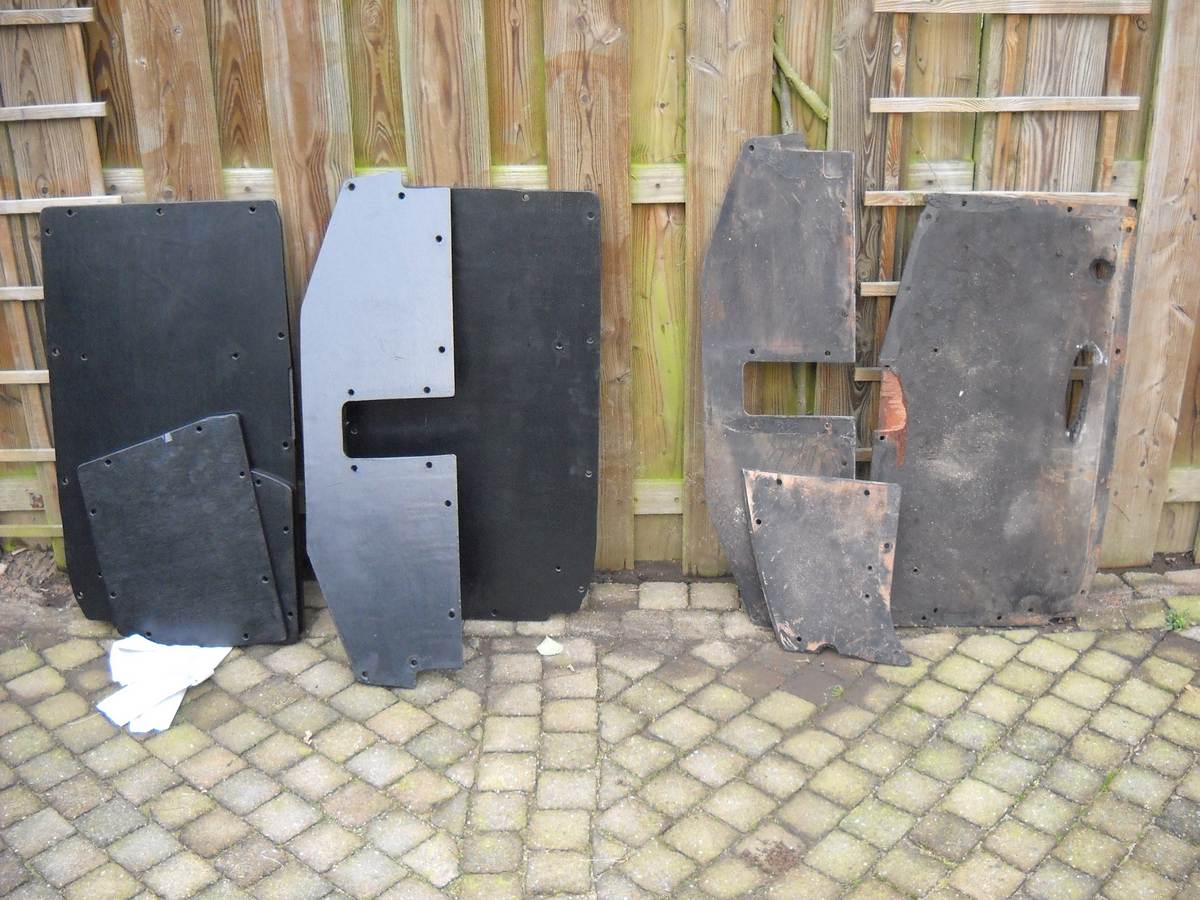
Car fender archeology

 In some cases there were little rust spots where the metal had become very thin. By welding it up and grinding it flat again those spots were easily repaired. In other places the rust monster had progressed just a bit too much and a piece was cut out and a new fresh piece of sheet was formed to fill the gap. It took a long time, but eventually the fender regained its original strength and shape. Still it seems that the rear fenders are still the original ones. The lower 3 layers seem to be the original 3 layers of paint as it came out of the factory in Abingdon England, with the light green as the top coat. It is also impressive that despite the thick layers of filler that was used, the paint did not peel off over time.
In some cases there were little rust spots where the metal had become very thin. By welding it up and grinding it flat again those spots were easily repaired. In other places the rust monster had progressed just a bit too much and a piece was cut out and a new fresh piece of sheet was formed to fill the gap. It took a long time, but eventually the fender regained its original strength and shape. Still it seems that the rear fenders are still the original ones. The lower 3 layers seem to be the original 3 layers of paint as it came out of the factory in Abingdon England, with the light green as the top coat. It is also impressive that despite the thick layers of filler that was used, the paint did not peel off over time.


Dings and dents and worse...
 When we first got the car, only a few dents we visible. The rear of the car had suffered a significant blow once. Judging by the rust visible in the dent, it has been there a while. How do we tackle such a problem? How to get the dent back out? First we do some research in literature and on the internet. And then we just grab a couple of hammers and start. The trick is not to hammer too much. In case the sheet metal is hit by a foreign object, part of the metal will deform permanently. Other areas will just bend because of this initial deformation, but will bend back like a spring once the deformation is eliminated. It is best to only work on those points in the sheet metal that are directly hit.
When we first got the car, only a few dents we visible. The rear of the car had suffered a significant blow once. Judging by the rust visible in the dent, it has been there a while. How do we tackle such a problem? How to get the dent back out? First we do some research in literature and on the internet. And then we just grab a couple of hammers and start. The trick is not to hammer too much. In case the sheet metal is hit by a foreign object, part of the metal will deform permanently. Other areas will just bend because of this initial deformation, but will bend back like a spring once the deformation is eliminated. It is best to only work on those points in the sheet metal that are directly hit.
During the time consuming process of working out the dings and dents you realize one thing: Getting it out takes longer than getting a dent in... The latter is also much easier. The picture here shows the first steps. Gentle taps are better than hard blows. Keeping a dolly on the other side of the metal helps flattening out the dings. First you need to 'look' for the dolly as it is on the other side of the metal. You can do that by just tapping with the hammer and listen for the sound. Once you hear a high pitched 'pling' you know that you are on the dolly. A large file can reveal local low and high areas. A temporarily layer of high gloss plaint also helps. We also need that to protect the sheet metal for rusting before it gets the final paint, which is still some time away. The picture shows that after step 1, 2 and 3 a 4th step is still required. Once we are at that point, we will surely add that to the site.
It is getting serious...





If the weather is not good, or you are sick of all the rust, there are many other parts you can work on to cheer you up again. The different elements from the dashboard as well as all the metal parts from the engine are cleaned with a wire brush and painted again. Those parts are all waiting for the engine to return. The machine shop is almost ready so in a few weeks I can pick it up again and put everything back together again. Can't wait ... The only part still in the car is the gearbox. The main reason for this fact is because there is no space left in the garage!


